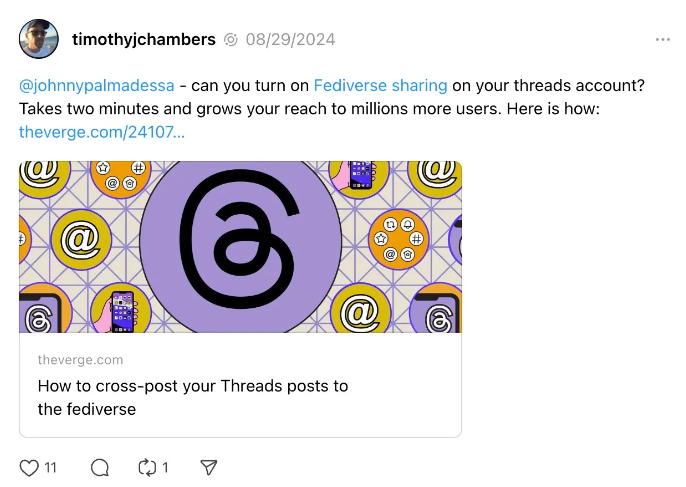A big step in furthering this goal of integration with the open social web has been made by Meta’s X competitor, Instagram Threads. In a recent update, Threads introduced a feature for a direct link to enable fediverse sharing, making that process much easier for users. This feature makes it easy for users to request that others enable fediverse sharing by simply sharing a URL, so that more users can easily embrace the fediverse and extend their content’s reach beyond Meta’s platform.
It would require just a click on a shared URL to turn this key feature on, sans the need to dive deep into several settings-a move that could further accelerate the adoption of Threads as a key player in the fediverse ecosystem.
What is Fediverse, and Why Should Threads Users Care?

What’s meant by the term “fediverse” is that it’s a network of independently owned social networks, mostly interconnected through protocols for decentralization, like ActivityPub. What really sets the fediverse apart from traditional social media platforms, however, is how it lets users communicate across a multitude of services not controlled by one entity. This gives users greater ownership of their data and content while granting a wider audience for their posts.
But what really sets Instagram Threads apart from any other social network is that it offers fediverse sharing: the ability for users to share their content not just on Threads but also on other services, such as Mastodon and WordPress, among others that support ActivityPub. This move constitutes one of the most significant moves by Meta to embrace open standards and protocols, enabling users to connect with a broader social ecosystem.
But despite that major feature, fediverse sharing isn’t turned on by default, and most users either don’t know how to turn it on or don’t see the benefit of doing so. That’s where this new direct link feature in Threads makes it a lot easier for people who are trying to argue in favor of fediverse sharing to take other people through the process.
Learn more about the fediverse and ActivityPub on W3C’s website.
A Quick Solution to a Common Problem
Instead, fediverse advocates of the Threads community used to write lengthy explanations and guides to users in order to encourage them to turn on the fediverse sharing. In fact, this used to confuse or sometimes even discourage them because they do not understand the concept. But today, with just a simple URL — https://www.threads.net/settings/account/fediverse — users can be whisked away to that setting where they could enable it. This allows them to extend the reach of their post from Threads to the wider fediverse with one click.
The new URL was unveiled at FediForum, an online conference where developers and other tech enthusiasts talked about developments and updates for the fediverse and other related technologies, which included ActivityPub, the AT Protocol driving platforms like Bluesky, and Nostr, a protocol favored by Twitter co-founder Jack Dorsey.
If Threads sharing on the fediverse is enabled, then users can post not only within Meta’s platform but also to the open web-a much larger audience. This will be part of Meta’s ongoing effort for allowing users of Threads to connect with the broader open social web, including platforms like Mastodon and others powered by ActivityPub.
How Does Fediverse Sharing Work?
After fediverse sharing is activated for a user of Threads, users on other platforms that are part of the fediverse will have visibility into that user’s content. How does that work? Threads uses ActivityPub, developed by the World Wide Web Consortium-or W3C for short-which helps different social networks be able to talk with one another.
Currently, for any post from a Threads user, replies and likes from fediverse users already surface in the comment thread of that post. With time, Meta will also allow users of Threads to directly follow and interact with users on the fediverse from within their Threads account.
Recent updates to Threads have also introduced the ability to see fediverse replies on other users’ posts, making the platform more integrated with the open web. Not to be outdone, Threads even added support for syndicating content to the fediverse via its API, allowing third-party applications to post to Threads and the fediverse at the same time.
This is a big deal, as Meta has traditionally been of the “walled garden” type, keeping users in and interactions with other platforms to a minimum. This move sees the company throw caution to the wind by embracing open protocols like ActivityPub, adding yet another arrow to its quiver of support for open social web standards-and perhaps setting a precedent for other tech giants to follow.
Why You Should Enable Fediverse Sharing
If you’re on Threads and haven’t turned on sharing to the fediverse yet, now is the time. You’ll be hugely expanding the reach of your content beyond just Threads or even Meta’s ecosystem. Whether you’re a content creator, an influencer, or just someone who wants more exposure for their posts, fediverse sharing is very valuable.
Given that more users from the likes of Mastodon and others can now follow accounts on Threads, this will only hasten the pace at which barriers between social media sites become increasingly blurred. But as Threads make it easier to share content across the open social web, users should be making full use of such an opportunity to reach out to a wider audience.
With the new direct link feature, enabling fediverse sharing has never been easier. Just share this link with your friends or followers, and they can turn on the setting with a single click.
Meta’s Vision for the Future of Social Media
This push by Meta to integrate open protocols, like ActivityPub, into Threads is only part of a greater vision that aims to redefine the social media landscape. Supporting the open social web, Meta positions Threads to be a major player in this future of decentralized social networking, where users will have more control over their data and how it’s shared.
This opens up whole new avenues of possibility not only for users but also for developers. Imagine a future where social media is less and less dominated by a few centralized behemoths, and we are free to join whichever platforms we want while remaining interconnected through the open web.
Meanwhile, Threads users will continue to get more updates and features that make it even easier and seamless to interact with the fediverse. It’s clear that as Meta continues to fine-tune its integration with the open social web, Threads is just getting started.
In short, Threads is democratizing more interaction across different social media platforms by introducing a new feature in the form of a direct link for sharing on fediverse platforms. What this powerful tool requires is just one click to turn it on and expand your content’s reach beyond Meta’s ecosystem while contributing to the growth of the open social web.
Stay updated: Tech News


